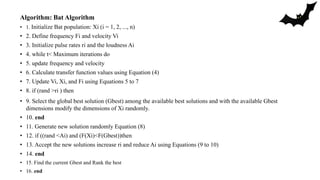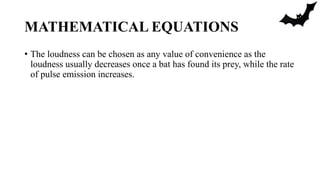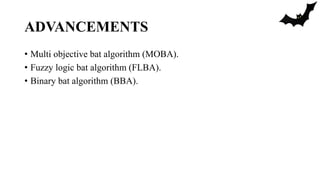Bat algorithm
- 3. • After hitting and reflecting, the bats transform their own pulse into useful information to explore how far away the prey is. • The pulse rate can be simply determined in the range from 0 to 1, where 0 means that there is no emission and 1 means that the bat’s emitting is their maximum.
- 4. • Bat sends signal with frequency f. • Echo signal used to calculate the distance. B C1 C2 C3 B C1 C2 C3 Frequency Frequency S1 S2 S3
- 5. IDEALIZED RULES FOR BAT ALGORITHM • All bats use echolocation to sense distance and they know the difference between food/prey. • velocity “vi” • at position “Xi” • with a fixed frequency “f” min , • varying wavelength λ • and loudness A0 to search for prey. • They can automatically adjust the wavelength of their emitted pulses and adjust the rate of pulse emission r[0,1], depending on the proximity of the target.
- 6. velocity “vi” position “Xi” frequency “fmin” wavelength λ loudness A0
- 7. Algorithm: Bat Algorithm • 1. Initialize Bat population: Xi (i = 1, 2, ..., n) • 2. Define frequency Fi and velocity Vi • 3. Initialize pulse rates ri and the loudness Ai • 4. while t< Maximum iterations do • 5. update frequency and velocity • 6. Calculate transfer function values using Equation (4) • 7. Update Vi, Xi, and Fi using Equations 5 to 7 • 8. if (rand >ri ) then • 9. Select the global best solution (Gbest) among the available best solutions and with the available Gbest dimensions modify the dimensions of Xi randomly. • 10. end • 11. Generate new solution randomly Equation (8) • 12. if ((rand <Ai) and (F(Xi)<F(Gbest))then • 13. Accept the new solutions increase ri and reduce Ai using Equations (9 to 10) • 14. end • 15. Find the current Gbest and Rank the best • 16. end
- 8. MATHEMATICAL EQUATIONS • Generating new solutions is performed by moving virtual bats according to the following equations: • 𝑓𝑖 = 𝑓 𝑚𝑖𝑛 + 𝑓𝑚𝑎𝑥 − 𝑓 𝑚𝑖𝑛 𝛽 • 𝑣𝑖 𝑡 = 𝑣𝑖 𝑡−1 + (𝑥𝑖 𝑡 − 𝑥∗) 𝑓𝑖 • 𝑥𝑖 𝑡 = 𝑥𝑖 𝑡−1 + 𝑣𝑖 𝑡 • Where βЄ[0,1] is a random vector drawn from a uniform distribution. • X* is the current global best location (solution) which is located after comparing all the solutions among all the bats.
- 9. MATHEMATICAL EQUATIONS • The current best solution according to the equation: • where δ Є[-1,1] is a random number, while At is the average loudness of all the best at this time step. 𝑥 𝑛𝑒𝑤 = 𝑥 𝑜𝑙𝑑 +𝛿𝐴 𝑡
- 10. MATHEMATICAL EQUATIONS • The loudness can be chosen as any value of convenience as the loudness usually decreases once a bat has found its prey, while the rate of pulse emission increases.
- 11. LOUDNESS AND PULSE EMISSION VS ITERARION 𝐴𝑖 𝑡+1 =∝ 𝐴𝑖 𝑡 𝑟𝑖 𝑡+1 = 𝑟𝑖 0 [1-exp(-𝛾t)]
- 12. FLOW CHART
- 13. EXAMPLE – SEGMENTATION • The multilevel threshold problem can be configured as a k- dimensional optimization problem for optimal thresholds [t1,t2,…tk] which optimizes an objective function. • The objective function is determined from the histogram of the image, denoted as h(i), i = 0,1,2,…L-1, where h(i) represents the number of pixels having the gray level i.
- 14. EXAMPLE – SEGMENTATION • L gray levels in a given image I having M pixels and these gray levels are in the range {0,1,…L-1}. • The normalized probability at level i is defined by the ratio: pi = h(i)/M
- 15. ADVANCEMENTS • Multi objective bat algorithm (MOBA). • Fuzzy logic bat algorithm (FLBA). • Binary bat algorithm (BBA).
- 16. Algorithm 2: Binary Bat Algorithm • 1. Initialize Bat population: Xi (i = 1, 2, ..., n) rand(0 or 1) and Vi= 0 • 2. Define pulse frequency Fi • 3. Initialize pulse rates ri and the loudness Ai • 4. whilet < Maximum iterations do • 5. update velocities and adjust frequencies • 6. Using Equation (11) Calculate transfer function value • 7. Using Equation (12) update Xi • 8. if (rand >ri ) then • 9. Select the global best solution (Gbest) among the available best solutions and with the available Gbest dimensions modify the dimensions of Xi randomly • 10. end • 11. Generate new solution randomly • 12. if ((rand <Ai) and (F(Xi)<F(Gbest))then • 13. Accept the new solutions increase ri and reduce Ai using Equations (9 to 10) • 14. end • 15. Find the current Gbest and Rank the best • 16. end
- 17. COMPARATIVE ANALYSIS ALGORITHM BASED ON DEFINED BY FEATURES AREA OF APPLICATION BAT Echo location behavior of bat Pulse rate emission and loudness Accurate and efficient Engineering design and classification FIREFLY Flashing behavior of firefly Brightness and attractiveness Finds a good solution in less number Digital image processing CUCKOO SEARCH Brooding of cuckoo Color of eggs Simple implementation Nano technology
- 18. WHY BAT ALGORITHM IS BETTER? 1. Automatic zooming. 2. Parameter control. 3. Frequency tuning. 4. More number of solutions.
- 19. ADVANTAGES OF BAT • Solve a wide range of problems and highly non-linear problems efficiently. • It gives promising optimal solutions. • The loudness and the pulse emission rates essentially provides a mechanism for automatic control and auto-zooming into region. • Number of solutions increases in the library and so more accurate options are available.
- 20. IMPROVEMENTS REQUIRED • Bat algorithm converge quickly at the early stage and then the convergence rate slows down. • There is no mathematical analysis to link the parameters with convergence rates. • It is not clear what the best values are for most application.
- 21. Thank You
- 22. Questions ?




![IDEALIZED RULES FOR BAT ALGORITHM
• All bats use echolocation to sense distance and they know the
difference between food/prey.
• velocity “vi”
• at position “Xi”
• with a fixed frequency “f” min ,
• varying wavelength λ
• and loudness A0 to search for prey.
• They can automatically adjust the wavelength of their emitted pulses
and adjust the rate of pulse emission r[0,1], depending on the
proximity of the target.](https://image.slidesharecdn.com/batalgorithm-170406072944/85/Bat-algorithm-5-320.jpg)


![MATHEMATICAL EQUATIONS
• Generating new solutions is performed by moving virtual bats
according to the following equations:
• 𝑓𝑖 = 𝑓 𝑚𝑖𝑛 + 𝑓𝑚𝑎𝑥 − 𝑓 𝑚𝑖𝑛 𝛽
• 𝑣𝑖
𝑡
= 𝑣𝑖
𝑡−1
+ (𝑥𝑖
𝑡
− 𝑥∗) 𝑓𝑖
• 𝑥𝑖
𝑡
= 𝑥𝑖
𝑡−1
+ 𝑣𝑖
𝑡
• Where βЄ[0,1] is a random vector drawn from a uniform distribution.
• X* is the current global best location (solution) which is located after
comparing all the solutions among all the bats.](https://image.slidesharecdn.com/batalgorithm-170406072944/85/Bat-algorithm-8-320.jpg)
![MATHEMATICAL EQUATIONS
• The current best solution according to the equation:
• where δ Є[-1,1] is a random number, while At is the average loudness
of all the best at this time step.
𝑥 𝑛𝑒𝑤 = 𝑥 𝑜𝑙𝑑 +𝛿𝐴 𝑡](https://image.slidesharecdn.com/batalgorithm-170406072944/85/Bat-algorithm-9-320.jpg)

![LOUDNESS AND PULSE EMISSION VS ITERARION
𝐴𝑖
𝑡+1
=∝ 𝐴𝑖
𝑡
𝑟𝑖
𝑡+1
= 𝑟𝑖
0
[1-exp(-𝛾t)]](https://image.slidesharecdn.com/batalgorithm-170406072944/85/Bat-algorithm-11-320.jpg)

![EXAMPLE – SEGMENTATION
• The multilevel threshold problem can be configured as a k-
dimensional optimization problem for optimal thresholds [t1,t2,…tk]
which optimizes an objective function.
• The objective function is determined from the histogram of the image,
denoted as h(i), i = 0,1,2,…L-1, where h(i) represents the number of
pixels having the gray level i.](https://image.slidesharecdn.com/batalgorithm-170406072944/85/Bat-algorithm-13-320.jpg)








